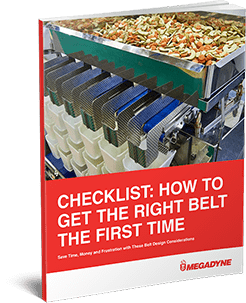Improper belt selection can quickly bring your operation to a standstill. Oftentimes maintenance personnel purchase a standard belt without first examining the effect that their products and process line may have on the belt itself. A thorough assessment can help to determine the right belt choice for a given application to ensure maximum service life.
Megadyne offers a diverse range of belts that meet the various challenges faced by industrial applications, such as size, weight, loading method, and type of material, to ensure that we can provide the right belt for any conveyance application.
Define Your Application
To analyze your application, consider the following factors:
- Direction
When choosing the right belt, consider whether you require general or bi-directional conveyance. You are more likely to require bidirectional conveyance if your belts are used for more than one purpose, such as shipping and receiving. - Operational Alignment
You'll also want to know whether your product handling application synchronizes with other parts of the conveying process. Evaluate the speed, timing, and amount of space available to ensure everything is in proper alignment with the right degree of belt pitch. - Slippage
Belt slippage is another factor to determine. Synchronous or timing belts are designed to prevent slippage, making them ideal in situations in which input and output shafts must be in sync. - Material
The type of material you are conveying will play a role in belt selection as well. For example, if your products are hot, cold, abrasive, or fragile, you will want to make sure your belt possesses the proper resistances to accommodate them. - Space Availability
Space limitations are always a primary concern in conveyance systems. A belt's drive dimensions allow us to calculate drive geometry. Drive geometry, in turn, determines belt length and ensures that the drive fits into the allotted space.
Some other things to consider during your belt selection process include:
- Pulley diameters and the center distance between shafts
- General environment and ambient temperature
- Industry-specific requirements that must be met (FDA, USDA, etc.)
- Budget requirements
- Desired delivery date
- Urgency of the project
For existing applications, it's essential to define any current problems that need to be resolved in advance of purchasing a new belt solution. New applications will require a thorough assessment to see that no detail is overlooked. Failing to conduct a proper inquiry could result in unexpected downtime, which can have a severe impact on the bottom line for both new and existing operations.
Basic Belt Types
Once you’ve defined the parameters and challenges of your operation, it is then time to choose the right belt. Belt solutions offered by Megadyne include:
- Rubber Timing Belts, which can be endless or open-ended with a steel or fiberglass cord.
- Polyurethane Timing Belts designed for carrying food products. Our Molded Endless Megapower and Megapower FC belts are created using a dedicated thermoset mold to ensure precise length and thickness.
- Open-Ended Polyurethane Belts are made from thermoplastic and can be joined endless and manufactured to custom lengths. Mechanical pin splicing is available using Megadyne's Progressive Pin Joint (PPJ) process, guaranteeing quick installation.
- Truly Endless Polyurethane Flex belts are created using special production methods that allow for thermoplastic extrusion of long, high-strength, endless belts. These are ideal for conveyors with long center distance, and provide the most positive form of synchronous motion with dynamic true tracking. These belts are ideal for side-loading and unloading applications.
- Rubber V-Belts come with a wrapped or raw edge and are available in all popular cross-sections.
- Poly-rib serpentine belts are manufactured from polyurethane and rubber, enabling a higher level of tension and reduced slippage.
- Conveyor belts made from TPU, PVC, or fabric.
- Flat rubber and polyurethane belts available in cast, extruded, knit type, and woven.
Choose the Right Belt for your Application
There are many aspects to consider when choosing the right belt. On the surface, purchasing a belt may seem to be a simple process, but taking the time to carefully select your conveyor belts will guarantee longer service life, less downtime, and reduced maintenance requirements.
For more information, please download our eBook, “Checklist: How to Get the Right Belt.” Also, please feel free to contact us with questions about our belt solutions and how they can improve the efficiency of your application.
